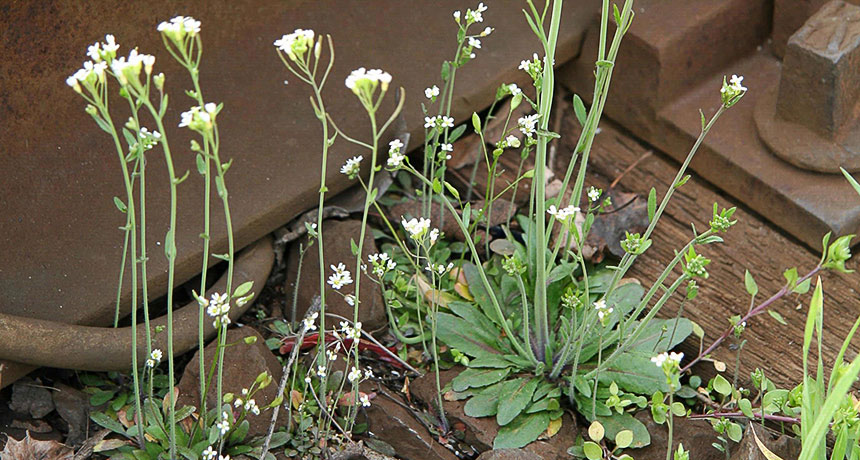Arabidopsis thaliana A weedy mustard plant frequently used to study the growth and behavior of plants. It is so commonly used by plant scientists that it has come to be called the “lab rat” of green-plant studies.
biology The study of living things. The scientists who study them are known as biologists.
bug The slang term for an insect. Sometimes it’s even used to refer to a germ.
carbon The chemical element having the atomic number 6. It is the physical basis of all life on Earth. Carbon exists freely as graphite and diamond. It is an important part of coal, limestone and petroleum, and is capable of self-bonding, chemically, to form an enormous number of chemically, biologically and commercially important molecules.
carbon dioxide (or CO2) A colorless, odorless gas produced by all animals when the oxygen they inhale reacts with the carbon-rich foods that they’ve eaten. Carbon dioxide also is released when organic matter burns (including fossil fuels like oil or gas). Carbon dioxide acts as a greenhouse gas, trapping heat in Earth’s atmosphere. Plants convert carbon dioxide into oxygen during photosynthesis, the process they use to make their own food.
chemical A substance formed from two or more atoms that unite (bond) in a fixed proportion and structure. For example, water is a chemical made when two hydrogen atoms bond to one oxygen atom. Its chemical formula is H2O. Chemical also can be an adjective to describe properties of materials that are the result of various reactions between different compounds.
crop (in agriculture) A type of plant grown intentionally grown and nurtured by farmers, such as corn, coffee or tomatoes. Or the term could apply to the part of the plant harvested and sold by farmers.
defense (in biology) A natural protective action taken or chemical response that occurs when a species confront predators or agents that might harm it. (adj. defensive)
DNA (short for deoxyribonucleic acid) A long, double-stranded and spiral-shaped molecule inside most living cells that carries genetic instructions. It is built on a backbone of phosphorus, oxygen, and carbon atoms. In all living things, from plants and animals to microbes, these instructions tell cells which molecules to make.
ecology See A branch of biology that deals with the relations of organisms to one another and to their physical surroundings. A scientist who works in this field is called an ecologist.
gene (adj. genetic) A segment of DNA that codes, or holds instructions, for a cell’s production of a protein. Offspring inherit genes from their parents. Genes influence how an organism looks and behaves.
insect A type of arthropod that as an adult will have six segmented legs and three body parts: a head, thorax and abdomen. There are hundreds of thousands of insects, which include bees, beetles, flies and moths.
mutation (v. mutate) Some change that occurs to a gene in an organism’s DNA. Some mutations occur naturally. Others can be triggered by outside factors, such as pollution, radiation, medicines or something in the diet. A gene with this change is referred to as a mutant.
pesticide A chemical or mix of compounds used to kill insects, rodents or other organisms harmful to cultivated plants, pets or livestock; or unwanted organisms that infest homes, offices, farm buildings and other protected structures.
Proceedings of the National Academy of Sciences A prestigious journal publishing original scientific research, begun in 1914. The journal's content spans the biological, physical, and social sciences. Each of the more than 3,000 papers it publishes each year, now, are not only peer reviewed but also approved by a member of the U.S. National Academy of Sciences.
protein A compound made from one or more long chains of amino acids. Proteins are an essential part of all living organisms. They form the basis of living cells, muscle and tissues; they also do the work inside of cells. Among the better-known, stand-alone proteins are the hemoglobin (in blood) and the antibodies (also in blood) that attempt to fight infections. Medicines frequently work by latching onto proteins.
species A group of similar organisms capable of producing offspring that can survive and reproduce.
vein Part of the body’s circulation system, these tubes usually carrying blood toward the heart.
viable Able to live and survive. (in biology) Able to survive and/or live a normal lifespan. (in engineering) Something that should work or operate according to plan, as in a “viable concept.”
weed (in botany) A plant growing wild in, around — and sometimes smothering over — valued plants, such as crops or landscape species (including lawn grasses, flowers and shrubs). Often a plant becomes such a botanical bully when it enters a new environment with no natural predators or controlling conditions, such as hard frosts.








